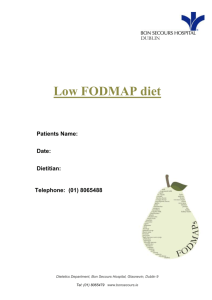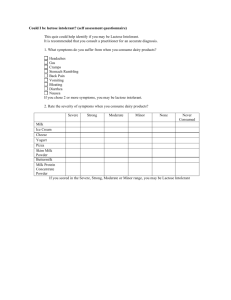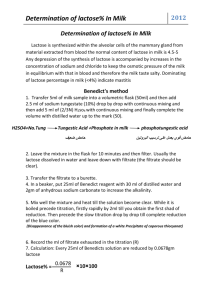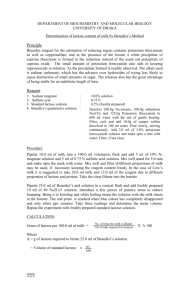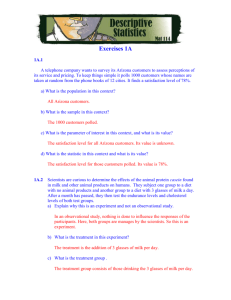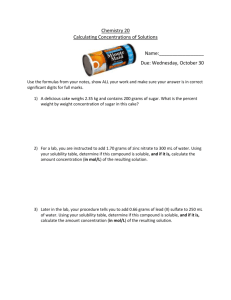The Low FODMAPs Diet
advertisement
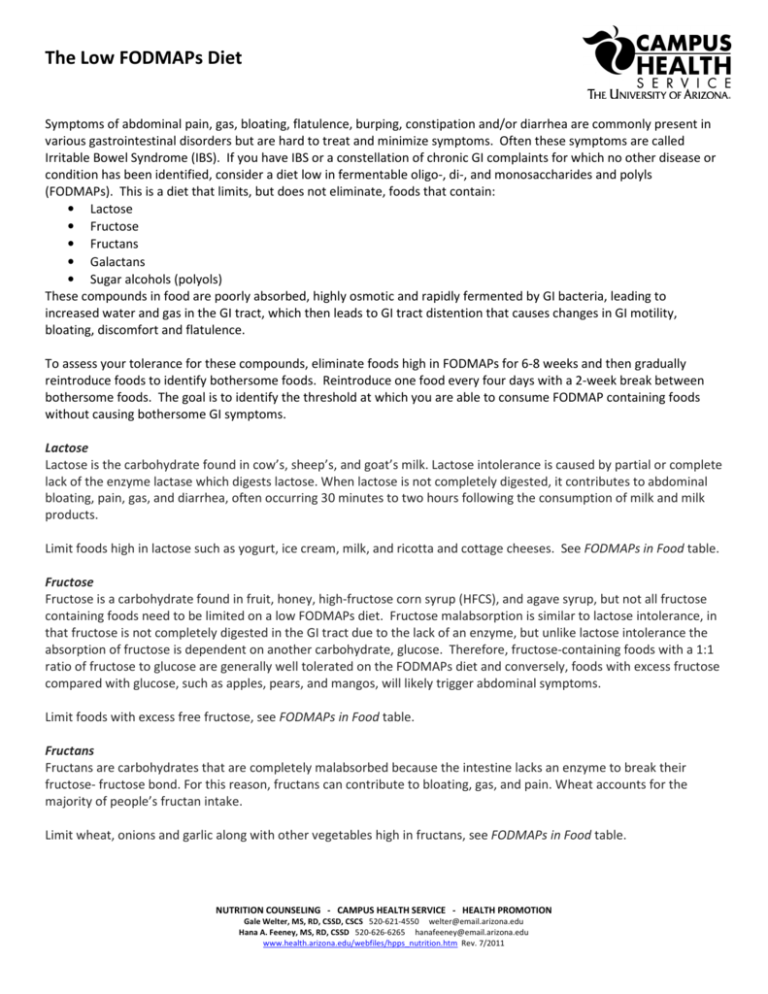
The Low FODMAPs Diet Symptoms of abdominal pain, gas, bloating, flatulence, burping, constipation and/or diarrhea are commonly present in various gastrointestinal disorders but are hard to treat and minimize symptoms. Often these symptoms are called Irritable Bowel Syndrome (IBS). If you have IBS or a constellation of chronic GI complaints for which no other disease or condition has been identified, consider a diet low in fermentable oligo-, di-, and monosaccharides and polyls (FODMAPs). This is a diet that limits, but does not eliminate, foods that contain: • Lactose • Fructose • Fructans • Galactans • Sugar alcohols (polyols) These compounds in food are poorly absorbed, highly osmotic and rapidly fermented by GI bacteria, leading to increased water and gas in the GI tract, which then leads to GI tract distention that causes changes in GI motility, bloating, discomfort and flatulence. To assess your tolerance for these compounds, eliminate foods high in FODMAPs for 6-8 weeks and then gradually reintroduce foods to identify bothersome foods. Reintroduce one food every four days with a 2-week break between bothersome foods. The goal is to identify the threshold at which you are able to consume FODMAP containing foods without causing bothersome GI symptoms. Lactose Lactose is the carbohydrate found in cow’s, sheep’s, and goat’s milk. Lactose intolerance is caused by partial or complete lack of the enzyme lactase which digests lactose. When lactose is not completely digested, it contributes to abdominal bloating, pain, gas, and diarrhea, often occurring 30 minutes to two hours following the consumption of milk and milk products. Limit foods high in lactose such as yogurt, ice cream, milk, and ricotta and cottage cheeses. See FODMAPs in Food table. Fructose Fructose is a carbohydrate found in fruit, honey, high-fructose corn syrup (HFCS), and agave syrup, but not all fructose containing foods need to be limited on a low FODMAPs diet. Fructose malabsorption is similar to lactose intolerance, in that fructose is not completely digested in the GI tract due to the lack of an enzyme, but unlike lactose intolerance the absorption of fructose is dependent on another carbohydrate, glucose. Therefore, fructose-containing foods with a 1:1 ratio of fructose to glucose are generally well tolerated on the FODMAPs diet and conversely, foods with excess fructose compared with glucose, such as apples, pears, and mangos, will likely trigger abdominal symptoms. Limit foods with excess free fructose, see FODMAPs in Food table. Fructans Fructans are carbohydrates that are completely malabsorbed because the intestine lacks an enzyme to break their fructose- fructose bond. For this reason, fructans can contribute to bloating, gas, and pain. Wheat accounts for the majority of people’s fructan intake. Limit wheat, onions and garlic along with other vegetables high in fructans, see FODMAPs in Food table. NUTRITION COUNSELING - CAMPUS HEALTH SERVICE - HEALTH PROMOTION Gale Welter, MS, RD, CSSD, CSCS 520-621-4550 welter@email.arizona.edu Hana A. Feeney, MS, RD, CSSD 520-626-6265 hanafeeney@email.arizona.edu www.health.arizona.edu/webfiles/hpps_nutrition.htm Rev. 7/2011 The Low FODMAPs Diet Galactans Galactans are carbohydrates are malabsorbed for the same reason as fructans; the intestine does not have the enzyme needed to break down galactans. Consequently, galactans can contribute to gas and GI distress. Limit beans and lentils. See FODMAPs in Food table. Polyols Polyols are also known as sugar alcohols. They are found naturally in some fruits and vegetables and added as sweeteners to sugar-free gums, mints, cough drops, and medications. Sugar alcohols have varying effects on the bowel. Limit sugar alcohols, sorbitol, xylitol, mannitol and maltitol. See FODMAPs in Food table. FODMAPs Elimination and Challenge Use the table below to guide your choices. Eliminate foods high in FODMAPs for 6-8 weeks. You should notice an improvement in your GI complaints within one week of following a low FODMAP diet. Follow a low FODMAP diet for a full 6-8 weeks before assessing its effectiveness and reintroducing foods high in FODMAPs. At that time you will work with you Nutrition Counselor to reintroduce one test food every four days; if you react to a food, do not test another food for two weeks. Foods that are high in FODMAPs may aggravate your GI complaints but they are not causing an allergic reaction or an autoimmune reaction in your body. The foods high in FODMAPs that elicit GI symptoms are causing functional discomfort in your gut that result in gas, bloating, distention etc. These are the test foods for each category: • Lactose: ½-1 cup milk • Fructose: ½ mango or 1-2 teaspoons honey • Fructans: 2 slices wheat bread, 1 garlic clove or 1 cup pasta • Galactans: ½ cup lentils or chickpeas • Sugar alcohols (polyols): Sorbitol, 2-4 dried apricots; Mannitol, ½ cup mushrooms You will work with your Nutrition Counselor to determine the order of challenge and which foods to use. NUTRITION COUNSELING - CAMPUS HEALTH SERVICE - HEALTH PROMOTION Gale Welter, MS, RD, CSSD, CSCS 520-621-4550 welter@email.arizona.edu Hana A. Feeney, MS, RD, CSSD 520-626-6265 hanafeeney@email.arizona.edu www.health.arizona.edu/webfiles/hpps_nutrition.htm Rev. 7/2011 The Low FODMAPs Diet FODMAPs in Food Type of food High in FODMAPs Low in FODMAPs Milk Milk: Cow, Sheep, Goat, Soy Creamy soups made with milk Evaporated milk Sweetened condensed milk Yogurt Cow’s milk yogurt (Greek yogurt is lowest in FODMAPs) Soy yogurt Cottage cheese Ricotta cheese Marscapone cheese Milk: Almond, Coconut, Hazelnut, Hemp, Rice Lactose free cow’s milk Lactose free keifer Lactose free ice cream (non-dairy alternatives) Purchase lactase enzyme to make your own evaporated or condensed milk if needed Coconut milk yogurt Cheese Dairy-based condiments Sour cream Whipping cream Dairy-based desserts Ice cream Frozen yogurt Sherbet Apples, Pears Cherries, Raspberries, Blackberries Watermelon Nectarines, White peaches, Apricots, Plums, Peaches Prunes Mango, Papaya Persimmon Orange juice Canned fruit Large portions of any fruit Fruit Hard cheeses including cheddar, Swiss, brie, blue cheese, mozzarella, parmesan, and feta No more than 2 tablespoons ricotta or cottage cheese Lactose free cottage cheese Butter Half and half Cream cheese Sorbet from FODMAPs friendly fruit Banana Blueberries, Strawberries Cantaloupe, Honeydew Grapefruit, Lemon, Lime Grapes Kiwi Pineapple Rhubarb Tangelos <1/4 avocado <1 tablespoon dried fruit Limit consumption to one low FODMAPs fruit per meal Consume ripe fruit; firm, less-ripe fruit contains more fructose NUTRITION COUNSELING - CAMPUS HEALTH SERVICE - HEALTH PROMOTION Gale Welter, MS, RD, CSSD, CSCS 520-621-4550 welter@email.arizona.edu Hana A. Feeney, MS, RD, CSSD 520-626-6265 hanafeeney@email.arizona.edu www.health.arizona.edu/webfiles/hpps_nutrition.htm Rev. 7/2011 The Low FODMAPs Diet FODMAPs in Food Type of food High in FODMAPs Low in FODMAPs Vegetables Artichokes Asparagus Sugar snap peas Cabbage Onions Shallot Leek Onion and garlic salt powders Garlic Cauliflower Mushrooms Pumpkin Green peppers Grains Wheat Rye Barley-large quantities Spelt Legumes Chickpeas, Hummus Kidney beans, Baked beans Edamame, Soy milk Lentils Bok choy, Bean sprouts Red bell pepper Lettuce, Spinach Carrots Chives, Spring onion (green part only) Cucumber Eggplant Green beans Tomato Potatoes Garlic infused oil; sauté onion and garlic in oil and then discard onion and garlic Water chestnuts <1 stick celery <1/2 cup sweet potato, broccoli, Brussels sprouts, butternut squash, fennel <10 snow peas Brown rice Oats, oat bran Quinoa Corn Gluten-free bread, cereals, pastas and crackers without honey, apple/pear juice, agave or HFCS Namaste Food Perfect Flour Blend or King Arthur Gluten Free Multi-Purpose Flour Tofu Peanuts <1/3 cup green peas Nuts and Seeds Pistachios Sweeteners Honey Agave High fructose corn syrup Sorbitol, Mannitol, Xylitol, Maltitol Splenda (may alter friendly gut flora) Inulin FOS (fructo-oligosaccharides) Sugar alcohols (see sweeteners) Chicory root Rum Additives Alcohol Protein-rich food Fat-rich food 10-15 max or 1-2 tablespoons Almonds, Macadamia, Pecans, Pine nuts, Walnuts Pumpkin seed, Sesame seeds, Sunflower seeds Sugar Glucose, Sucrose Pure maple syrup Aspartame Wine, Beer Vodka, Gin Limit to one serving as all alcohol is a gastric irritant Fish, Chicken, Turkey, Eggs, Meat Olive and canola oil Olives <1/4 avocado NUTRITION COUNSELING - CAMPUS HEALTH SERVICE - HEALTH PROMOTION Gale Welter, MS, RD, CSSD, CSCS 520-621-4550 welter@email.arizona.edu Hana A. Feeney, MS, RD, CSSD 520-626-6265 hanafeeney@email.arizona.edu www.health.arizona.edu/webfiles/hpps_nutrition.htm Rev. 7/2011 The Low FODMAPs Diet Low FODMAP Menu options Breakfast • Erewhon Corn Flakes or oats, with rice or almond milk, banana and 1 tablespoon sliced almonds • McDonald’s or Starbucks oatmeal with 1 tablespoon dried fruit and nuts • Quinoa flakes with rice or almond milk, ¾ cup strawberries and 1 tablespoon pecans Lunch • Udi’s white bread sandwich with sliced turkey, lettuce or spinach leaves, tomato, sliced cheddar cheese and Green Valley lactose-free vanilla yogurt, ½ cup blueberries and baby carrots • Stir fry with brown rice or rice noodles, chicken, shrimp or beef, peppers and bok choy, ask for no onion or garlic and the sauce on the side • Fruit salad with 1 cup (total) low FODMAP fruits, kiwi, strawberries and blueberries, spinach salad with lemon dressing and cherry tomatoes, and brown rice cakes with natural almond butter Snack • • • • • • • Glutino pretzels or Blue Diamond Almond Nut thins and mozzarella string cheese Hard boiled egg and cherry tomatoes Pumpkin seeds Brown rice cakes with natural peanut butter Banana and handful almonds 1 stick celery with natural almond butter or, Carrots and red pepper dipped in tahini Dinner • Grilled chicken or salmon with baked sweet potato with olive oil or butter, sautéed spinach and read peppers seasoned with green parts of onion, salt, pepper, handful of pine nuts and olive oil, and a kiwi • Wendy’s baked potato and a side salad with chicken, bring your own homemade salad dressing that does not contain garlic or onion • Sushi Menu ideas adapted from Today’s Dietitian, March 2012 Online Resources for More Information www.katescarlata.com www.ibsfree.net References Gibson PR, Narrett, JS. Clinimal ramifications of malabsorption of fructose and other short-chain carbohydrates. Practical Gastroenterology, August 2007 http://www.mecfs-vic.org.au/sites/www.mecfs-vic.org.au/files/Article-BarrettPractGastro.pdf Gibson PR, Sheperd SJ. Evidence-based dietary management of functional gastrointestinal symptoms: The FODMAP approach. J of Gastroenterology and Hepatology 25(2010) 252-258 http://onlinelibrary.wiley.com/doi/10.1111/j.1440-1746.2009.06149.x/pdf Scarlata, K. Sucessful Low FODMAP living. Today’s Dietitian, March 2012 http://www.todaysdietitian.com/newarchives/030612p36.shtml Scarlata, K. The FODMAPs Approach — Minimize Consumption of Fermentable Carbs to Manage Functional Gut Disorder Symptoms. Today’s Dietitian, August 2010 http://www.todaysdietitian.com/newarchives/072710p30.shtml th Krause’s Food and The Nutrition Care Process, 13 edition by Mahan, Esott-stump and Raymond, 2011 NUTRITION COUNSELING - CAMPUS HEALTH SERVICE - HEALTH PROMOTION Gale Welter, MS, RD, CSSD, CSCS 520-621-4550 welter@email.arizona.edu Hana A. Feeney, MS, RD, CSSD 520-626-6265 hanafeeney@email.arizona.edu www.health.arizona.edu/webfiles/hpps_nutrition.htm Rev. 7/2011
